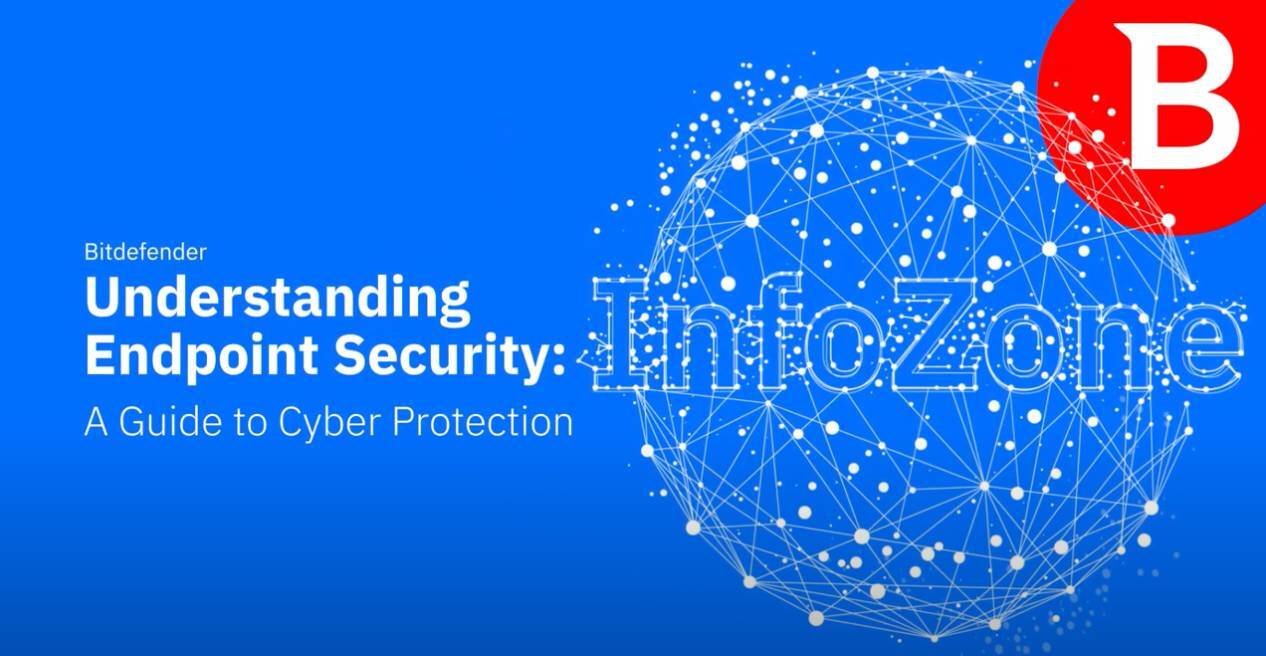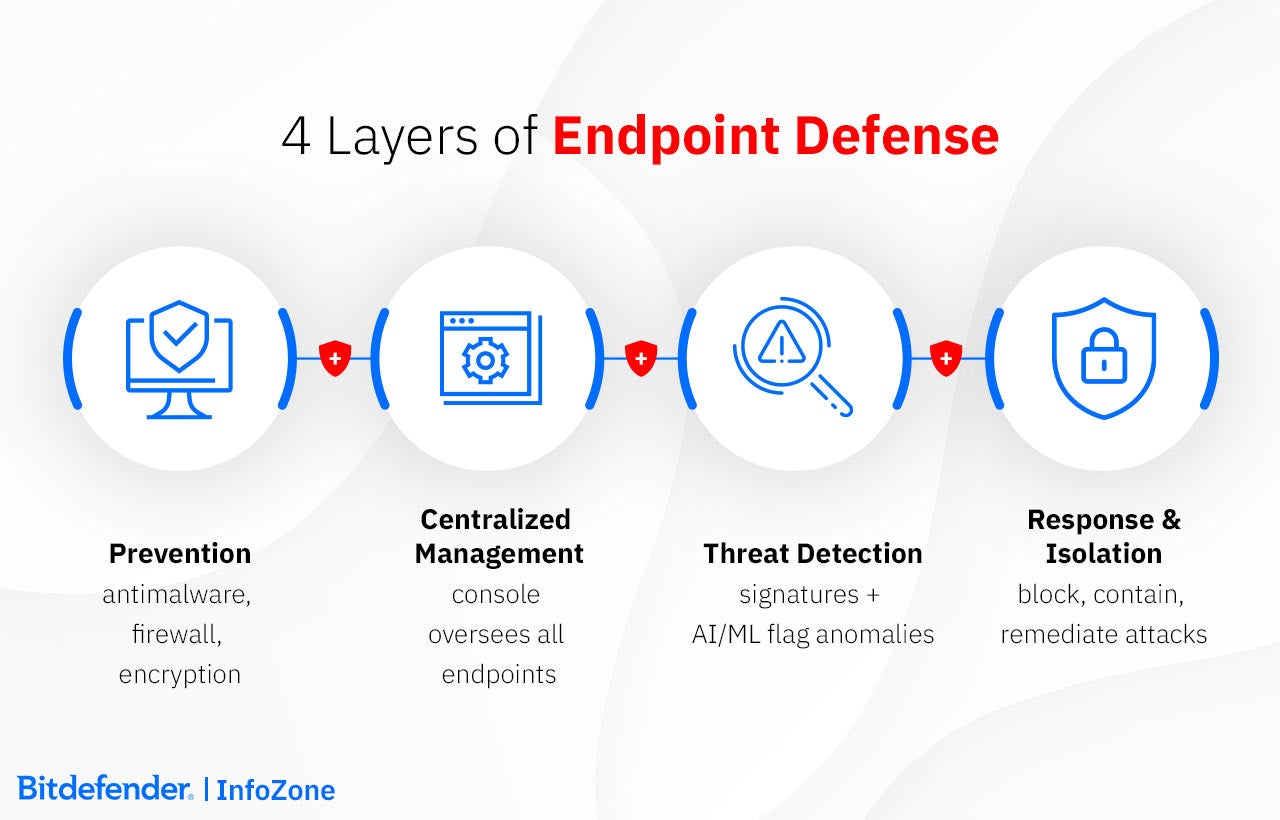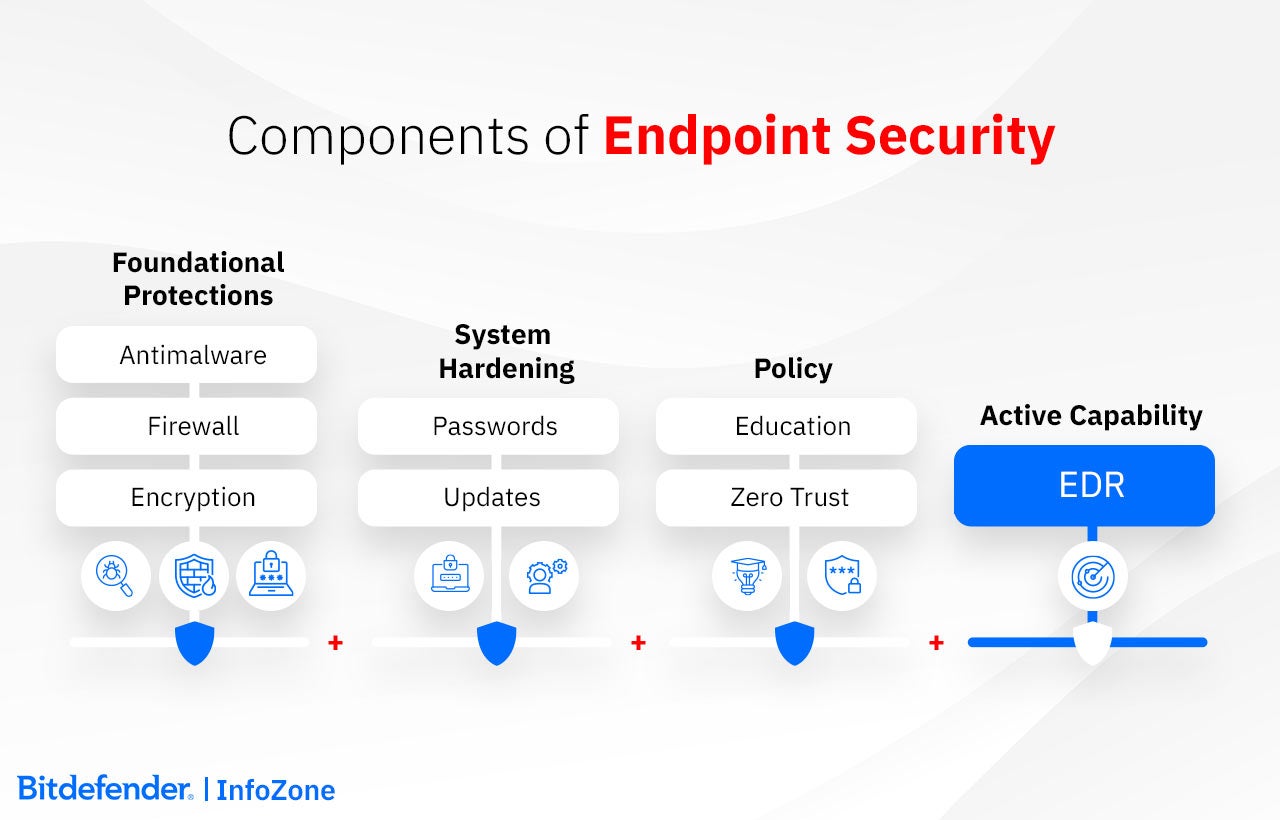“Didn’t you say you had it under control?” Discover why smart security teams choose GravityZone — before the chaos hits. Learn More >>
Endpoint security refers to the technological protocols and software deployed directly onto endpoints—like desktops, laptops, servers, and mobile devices—to monitor, prevent, detect, and counteract cyber threats. It fortifies each endpoint, whether connected to a local network or the cloud, ensuring they aren't exploited as gateways for malicious activities. This proactive measure integrates advanced threat detection, real-time monitoring, and software updates, offering a multi-layered defense against both conventional malware and sophisticated zero-day attacks.
An endpoint protection solution serves multiple functions in today's hyper-connected business environment. Its primary objectives include preventing unauthorized access to network assets, detecting ongoing cyberattacks, and swiftly isolating threats to minimize damage.
Given the alarming increase in cyberattacks, endpoint security has become a critical component, as it's often the last line of defense against infiltrations that can lead to data breaches. Reports indicate that a significant percentage of data breaches stem from vulnerabilities at the endpoint level, making modern endpoint security not just a supporting element but a cornerstone in a comprehensive cybersecurity strategy.
In the cybersecurity context, an endpoint refers to any device that interfaces with a network. This includes not only traditional computing devices such as desktops and laptops but also servers, mobile devices, smartwatches, wearables, and Internet of Things (IoT) gadgets.
Due to the proliferation of Bring Your Own Device (BYOD) policies and the increasing adoption of IoT, the network's landscape of potential endpoints — and, therefore, potential entry points for attackers — has expanded dramatically. Servers are considered as endpoints due to their critical role in network functionality and the potential risk they carry, particularly as threats can move laterally from user endpoints to servers, expanding the sphere of vulnerability.

Endpoint Security effectively merges varied technologies, deploying both localized and centralized strategies to bolster the defense of endpoints against cyber threats, thereby securing the entire organizational network. Understanding its dual-faceted operation, which utilizes local device defenses and centralized management, enables decision-makers to select solutions that meet their organization's cybersecurity needs.
Centralized Command and Deployment Strategies
Endpoint protection hinges on a centralized management console. Think of it as the control center for all your security protocols. From here, administrators can monitor, analyze, and respond to security incidents. Advanced solutions offer flexible deployment options: on-premises, cloud-based, or a hybrid of the two.
Endpoint Security Threat Detection
Endpoint protection uses two primary methods for threat detection:
Upon detecting a threat, immediate action is taken to block the suspicious data and isolate compromised files. Sophisticated tools then enable the rapid deployment of predefined protective measures.
Augmenting Security
Numerous organizations employ Managed Detection and Response (MDR) services, which uniquely combine technology with human expertise to enhance defense layers. These services not only provide proactive threat identification and elimination but also leverage the acumen of cybersecurity experts to interpret, investigate, and counteract threats with precision services, which uniquely combine technology with human expertise to enhance defense layers.

In an era where digital boundaries are continually expanding—thanks to the Internet of Things, remote and hybrid work, and cloud computing—endpoint devices like laptops, tablets, and smartphones have become the frontline in cybersecurity. These devices are the gateways to your organizational network, and they are often the initial targets for cyberattacks.
Financial and Legal Repercussions
A single breach can cost company millions in immediate damages, data theft, and long-term loss of customer trust. Not to mention, there are legal obligations to consider. Regulatory frameworks like HIPAA (The Health Insurance Portability and Accountability Act) and GDPR mandate robust security measures, including effective endpoint protection. The forthcoming NIS2 Directive introduces new cybersecurity standards and practices to enhance the resilience of essential services and digital service providers. Non-compliance with NIS2, GDPR, and HIPAA can lead to substantial fines and legal consequences, emphasizing the crucial role of strong endpoint security.
Brand Impact
A cybersecurity breach can have devastating effects on a company's brand, especially if it becomes public knowledge. The fallout may include customer churn, negative press, and a damaged reputation, which can have lingering effects on customer loyalty and business partnerships. This, in turn, may manifest as reduced revenue and loss of market share over both the short and long term.
Evolving Nature of Cyber Threats
As cyber threats continue to evolve, so must the measures organizations take. Gone are the days when traditional firewalls and antivirus software were enough. Today, cybercriminals employ advanced tactics like zero-day exploits and Advanced Persistent Threats (APTs) that require a new breed of endpoint protection. Hence, protection technologies are continually evolving to identify and counter these sophisticated threats effectively.
In summary, neglecting endpoint protection is a high stakes gamble that companies can ill afford. It isn't just an IT best practice; it's a business imperative that safeguards a company's financial well-being, legal standing, and overall reputation in today's digitally perilous landscape.
Preparing for a digital onslaught requires an arsenal of tools and strategies. Below is an insight into what usually constitutes a fortified framework:
Firewall: Traditionally more effective in a centralized work environment, firewalls control incoming and outgoing network traffic. However, with the rise of remote work, their effectiveness has shifted, requiring more dynamic solutions.
Zero Trust Model: By continually verifying identities and services, organizations add dynamic and proactive layers of security.

These can broadly be grouped into three main categories:
Selecting the right endpoint security software is a complex task that requires a comprehensive approach. Your choice should align with your organization's specific needs and vulnerabilities. Drawing on expert insights, here's a guide to essential and advanced features to consider in top-tier software.
Virus Scanning Software: A fundamental element that identifies and eliminates malware risks on various endpoint devices like servers, workstations, and virtual environments.
Proactive Threat Prevention: Elevates traditional Intrusion Detection Systems (IDS) by actively scanning and intercepting malicious activities in your network traffic.
Messaging Safeguards: Functions such as malware filtering for email attachments and anti-phishing mechanisms help neutralize email-borne risks.
A well-integrated endpoint security platform should offer a balanced blend of these essential and advanced features for seamless operation and robust protection. While not all organizations will need every feature, understanding what's available can guide you in making a more informed decision.
Endpoint protection is not just about prevention; it's also about rapid detection and effective response. Look for cybersecurity solutions that offer multi-layered security technologies, real-time threat visibility, and easy management through a single console to fully modernize your strategy.
Antivirus is generally a program designed to detect and remove known cyber threats like viruses and other types of malware from individual devices.
Endpoint protection, on the other hand, is a broader strategy and technology stack aimed at securing all endpoints in an organization's network.
This includes not only antivirus functionalities but also features like firewalls, threat hunting, predictive analytics, and endpoint detection and response (EDR), designed to provide a more comprehensive level of protection against a variety of advanced threats.
This term involves establishing and enforcing specific guidelines and protocols to ensure the security of individual devices that access a corporate network. This management framework might stipulate certain requirements, such as operating a verified OS, utilizing a VPN, or maintaining current antivirus protection.
Failure to meet these set standards can result in restricted network accessibility for non-compliant devices.
Traditional antivirus software focuses on preventing known malware attacks and relies on signature-based detection methods. While this is effective against known threats, it falls short in defending against more advanced, unknown threats.
Modern endpoint security solutions offer advanced features like behavioral analysis and predictive analytics, providing a more robust level of protection. Therefore, while antivirus is a good starting point, it is often insufficient for the advanced threats that organizations face today.